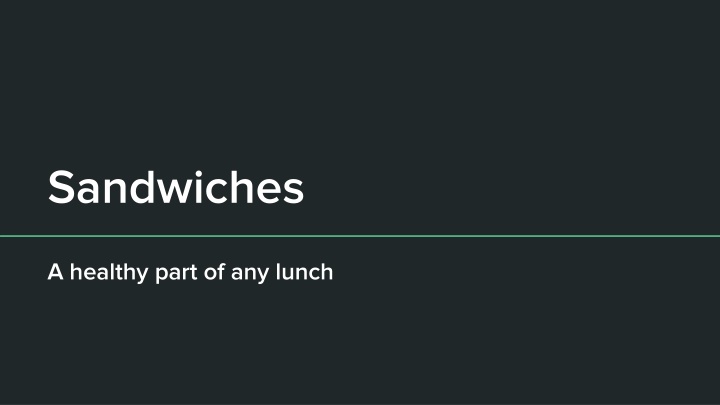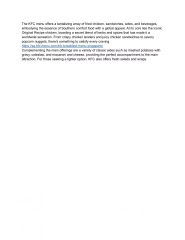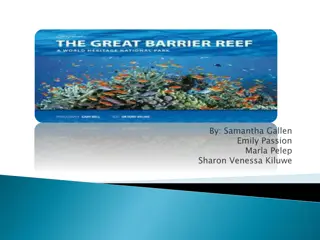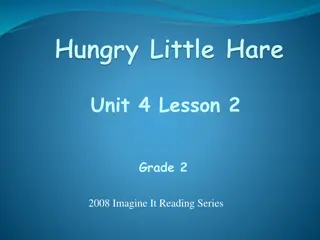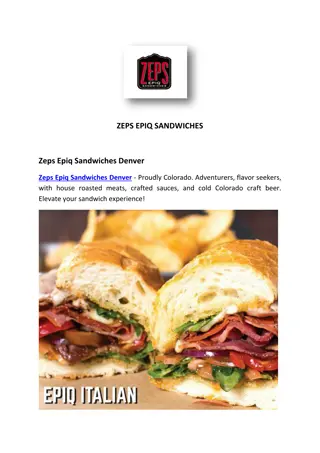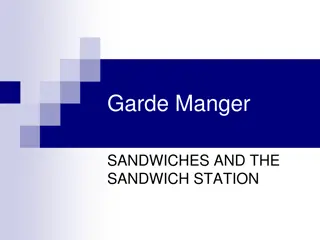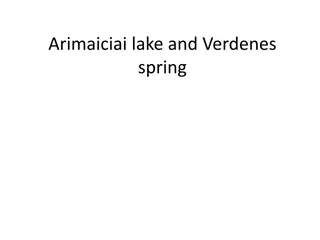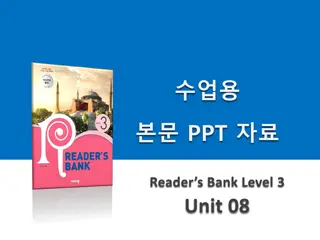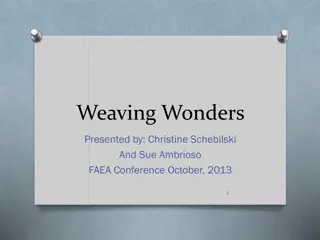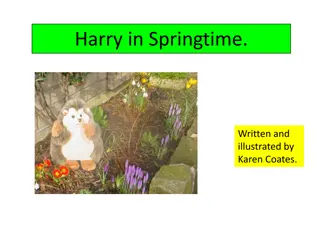Discovering the Wonders of Sandwiches
Sandwiches are a versatile and popular lunch option for many reasons. They are convenient, offer great value for money, and come in a wide variety to suit all tastes and dietary preferences. Learning about the different types of sandwiches, popular fillings, and creative ways to enhance their nutritional value can make lunchtime more exciting and nutritious. From open-faced to pinwheel sandwiches, there's a style for everyone to enjoy.
Download Presentation

Please find below an Image/Link to download the presentation.
The content on the website is provided AS IS for your information and personal use only. It may not be sold, licensed, or shared on other websites without obtaining consent from the author.If you encounter any issues during the download, it is possible that the publisher has removed the file from their server.
You are allowed to download the files provided on this website for personal or commercial use, subject to the condition that they are used lawfully. All files are the property of their respective owners.
The content on the website is provided AS IS for your information and personal use only. It may not be sold, licensed, or shared on other websites without obtaining consent from the author.
E N D
Presentation Transcript
Sandwiches A healthy part of any lunch
What Will We Learn Reasons why sandwiches are popular Types of sandwiches Popular breads and sandwich fillings Rules for making a sandwich & food safety Cost of a sandwich (why do they vary?) Suitable garnishes and accompaniments for a sandwich Packaging suitable for sandwiches Increasing the nutritional value of a sandwich
Why are sandwiches so popular? Download the summary document from Google Classroom. Spend two minutes thinking about this question. You will each be asked to contribute one answer. Type the answers into your summary document
Sandwiches are popular because. easy to make and serve good value for money easy to eat quickly or to take-away for customers who are rushing large variety available to suit a lot of tastes/ hot/cold fillings /toasted vegetarian/coeliac friendly versions available can be made to order-e.g. extra/less mayonnaise/butter often included in special offers/ lunch deals which makes them better value Are part of a nutritious lunch especially if salad ingredients are used
Types of Sandwiches Open or Open-Faced Plain Pinwheel Closed Tea Ribbon
Open Sandwich Open sandwiches use one kind of bread and have the filling on top. The bread slices can be cut into squares, tri- angles, or rounds. Sometimes butter is spread lightly on top and pieces of cheese or meat fillings are placed on top. They may be garnished with slices of carrots, raisins, pickles, and the like to make them more attractive. Open sandwiches are similar to canap s, a type of French hors d uvre.
Plain Sandwich A plain sandwich is made up of two slices of bread that is sometimes toasted. The crusts may or may not be removed, depending upon your preference. Butter, mayonnaise, or a prepared sandwich spread may be used as lining to prevent the bread from absorbing moisture from the filling. Spreads preventing the bread from becoming soggy, the spread also adds flavor and nutrients. It also ensures that the bread and the filling will stick together. Some examples you may be familiar with would include a roast beef sandwich or a grilled cheese.
Pinwheel Sandwich Pinwheels are made of a flatbread bread (like a tortilla) that is very thin. Fresh bread is preferable because it's easy to roll and will not crack. Spread bread with softened butter or margarine and your choice of any smooth filling, like creamed cheese, marmalades, cheese , peanut butter, jams, and jellies. Smooth fillings are ideal for pinwheel sandwiches, because they do not have bulk and can be spread thinly. Fill the bread with your chosen fillings. Roll the bread up tightly in cling film. Wrap each rolled sandwich individually and chill for several hours or until they are firm. When ready to serve, remove the cling film and cut into 2cm slices. Use a sharp knife or a bread knife so the cuts clear and neat. Arrange and serve them on a platter. Garnish if needed.
Closed Tea Sandwich Remove the crusts of a day-old bread. With cookie cutters of various shapes and sizes, cut as many pieces as possible from each sandwich. Try to have a variety of squares, rectangles, and oblong shapes. Save the scraps and crusts for crumbs. For each sandwich, spread butter on one piece of bread and filling on the other. Top the filled side with the buttered side. Closed tea sandwiches may be made ahead of time and frozen. After the sandwich is made place on wax paper or in a clean, damp towel and place in an airtight container to freeze. They should be removed from the freezer at least three hours before they are to be served.
Ribbon Sandwich A ribbon sandwich is basically a multi-layered sandwich. Bread, spread, meat, cheese, another layer of bread, meat cheese, third piece of bread. A ribbon one goes a step further by removing the crust and cutting the layered sandwich into 1inx1in square sections. Coloured bread is suitable for this type of sandwich. Alternate 3 slices each of white and brown bread with one or more fillings spread between slices. Press together the stack of slices, and then trim crusts. Wrap and chill for several hours. When ready to serve, cut into 2cm slices
Any sandwiches weve forgotten??? Have we forgotten anything? NEXT A LITTLE INDEPENDENT WORK IN YOUR SUMMARY DOCUMENT Name the breads we can use in these sandwiches .. Name the fillings that are popular in these sandwiches ...
Sandwich making rules There are some important rules for making sandwiches. Discuss why they are important: Think about the nutrients you re adding Use a spread on each slice of bread Wash your hands Add seasoning Add filling to fill all of the bread Use freshest ingredients
Food Hygiene and Safety in Sandwich Making What food hygiene and safety rules can be followed when making the following sandwiches: Prepacked for sale Made and served immediately for the consumer Made and served at home Packed for a picnic lunch
Look Local Spend some time researching the cost of a variety of sandwiches in three local fast food outlets (one can be the school canteen). Put this information together on the board. Are there differences in the prices? Give reasons for the differences in the price (summary document)
Garnishes & Accompaniments LIST OF EACH IN THE SUMMARY DOCUMENT A garnish is something used to decorate a sandwich and make it look more attractive when it is served. An accompaniment in something that is served with a sandwich to make it a more substantial meal.
Packaging for a sandwich Different types of packaging is available for foods: Metal (aluminum cans or tin foil) Glass Plastic Paper Answer this into the summary document: Which of these methods of packaging is suitable for a sandwich - give a reason why in each case.
Nutritionally balanced sandwich Each meal should have three food groups but does a sandwich have three food groups? Lets list the possibilities together ... Fruit & Veg Bread & Cereal Dairy Meat, Fish Alternatives
Making healthier choices. Let s think about how to make the following changes to your normal choice of sandwich. Work in teams on one heading before sharing your knowledge with the class: Increase Fibre Reduce Fat Increase Calcium Increase Fruit and Veg
Design a sandwich Design and make a sandwich for a teenagers school lunch. Use the handout to complete this task. You must meet the following criteria: - - - - It must be nutritionally balanced. It must show some chopping skills. You must use a healthy spread. You must state how it will be packaged.
